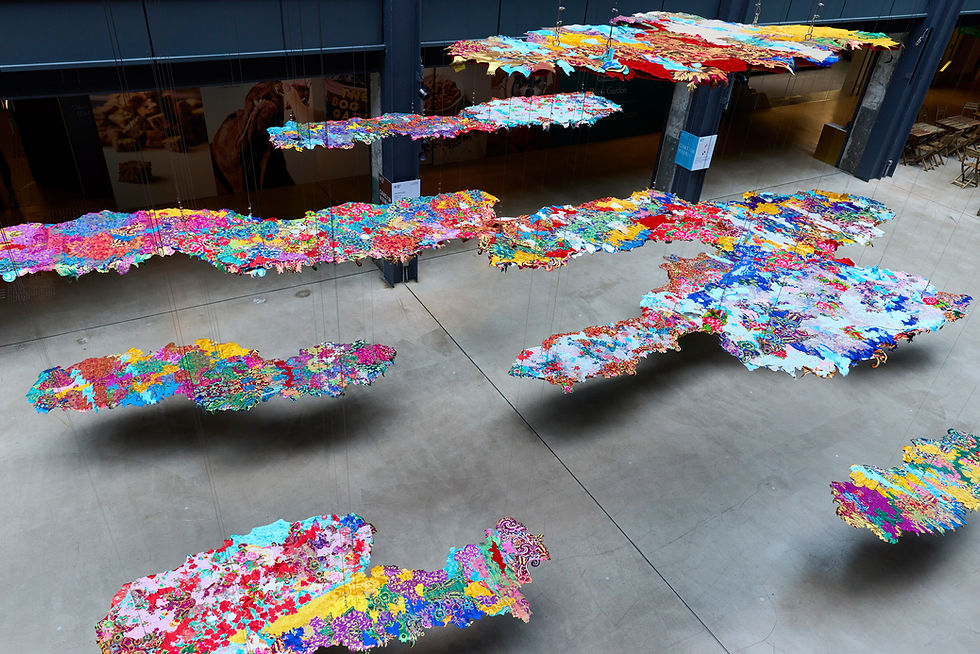Gagosian to Present Andy Warhol’s Long Shadow in Hong Kong
- Gen de Art

- Apr 12, 2024
- 3 min read
Updated: Feb 13, 2025
HONG KONG, March 21, 2024—Gagosian announce Andy Warhol’s Long Shadow in Hong Kong, on view March 25–May 11, 2024, and coinciding with Art Basel Hong Kong. Organized for the gallery by Jessica Beck, formerly of the Andy Warhol Museum, Pittsburgh, the exhibition considers Warhol’s ongoing cultural impact by juxtaposing key paintings, photographs, and films by the artist with works by some of his contemporaries and successors, including Derrick Adams, Jean- Michel Basquiat, Urs Fischer, Nan Goldin, Douglas Gordon, Alex Israel, Takashi Murakami, Richard Prince, Nathaniel Mary Quinn, Sterling Ruby, and Zeng Fanzhi.

Andy Warhol, Dollar Sign, 1981, acrylic and silkscreen ink on canvas, 90 ~ 70 inches (228.6 ~ 177.8 cm) © 2024 The Andy Warhol Foundation for the Visual Arts, Inc./Artists Rights Society (ARS), New York. Photo: Rob McKeever
Warhol was one of the most prolific artists of the twentieth century, and his work’s staying power has been augmented by its enormous diversity. Over the course of four decades, he continually reinvented his practice, moving from his intimate drawings of the 1950s to iconic silkscreened Pop paintings of celebrities, consumer goods, and disasters in the 1960s; portraits of the social elite in the 1970s; and photographs, television shows, and collaborative projects in the 1980s. This heterogeneity has seen Warhol’s legacy inform and inspire numerous contemporary artists.
Warhol’s paintings Silver Liz [Studio Type] (1963), Mao (1972), and Marilyn Monroe (1979), and his Screen Test film of Donyale Luna (1965–66), redefined portraiture in relation to contemporary style, power, and celebrity. In addition, Brillo Box (1964) and Dollar Sign (1981) brought commercial design and financial icons into the realm of fine art, while his Flowers (1964) and Shadows series (1978–79) introduced new modes of abstraction.
The new styles of representation that Warhol developed and his challenging of gender norms both resonate with the thematic centrality of identity, glamour, and performance to photographs by Nan Goldin, which here include Ivy in opera gloves, Boston (1972). Jean-Michel Basquiat’s double portrait of himself with Warhol, Dos Cabezas (1982), was made shortly after Basquiat first met his idol, while Sweet Pungent (1984–85) is one of more than 160 paintings on which the pair collaborated—it also saw Warhol return to painting by hand.

Four Marilyns (Reversal Series), 1979–86, Acrylic and silkscreen ink on canvas, 36 1/2 x 28 inches (92.7 x 71.1 cm), © 2024 The Andy Warhol Foundation for the Visual Arts, Inc. / Licensed by Artists Rights Society (ARS), New York, Photo: Martin Wong, Courtesy Gagosian
As often as Warhol experimented with new art-making strategies, he also reimagined his public persona through techniques of doubling, masking, and recording. In his Polaroid Self-Portrait in Fright Wig (1986), he alters his appearance by donning silver wig and sunglasses, also obscuring his features in shadow. Foregrounding an uneasy affinity with this approach, Douglas Gordon’s Self- Portrait of You +Me (2 piece) Andy (2008) comprises a commercial reproduction of a self-portrait of a bewigged Warhol that is partially burned, split, and mounted to a mirrored background. Dew (2023) by Urs Fischer employs post-Warholian strategies of appropriation and transformation of commercial imagery, while in The Athlete (2024), Nathaniel Mary Quinn interprets Polaroids and paintings of Muhammad Ali and Kareem Abdul-Jabbar from Warhol’s Athletes series, along with a Campbell’s soup can.
Zeng Fanzhi’s double portrait of himself and Warhol in Fly (2000) imagines the two artists—their features hidden behind identical masks—standing in a field of flowers, as two jets fly overhead. A new painting by Takashi Murakami echoes Warhol’s Flowers by abstracting from nature to create an instantly recognizable form, while Sky (2012) by Alex Israel recalls the Pop artist’s embrace of artificiality. Cool Down Bench (RWB) (2023) by Derrick Adams embraces popular culture, Untitled (2010) by Richard Prince employs a humor conversant with Warhol’s, and Sterling Ruby’s BC (4833) (2014) is inspired in part by Warhol’s Rorschach paintings. Through these works, Andy Warhol’s Long Shadow brings to light unexpected juxtapositions with artists whose work “thinks” through, with, and beyond Warhol’s oeuvre, demonstrating its enduring relevance.

Andy Warhol's Long Shadow, 2024, installation view, Photo: Martin Wong, Courtesy Gagosian

Andy Warhol's Long Shadow, 2024, installation view, Artwork © 2024 The Andy Warhol Foundation for the Visual Arts, Inc. / Licensed by Artists Rights Society (ARS), New York.
Photo: Martin Wong , ourtesy Gagosian
ANDY WARHOL’S LONG SHADOW
Opening reception: Monday, March 25, 6–8pm
March 25–May 11, 2024
Venue: Gagosian Hong Kong
(7/F Pedder Building, 12 Pedder Street, Central, Hong Kong)
Website



